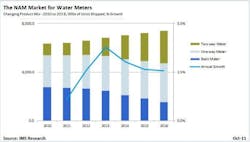Environmental protest groups notoriously throw spanners in the works to delay much–needed infrastructure. Poseidon Resources recently started construction of its Carlsbad Desalination Project in San Diego after years of public review. Tom Freyberg speaks to the company about its recent experience, looks at the relationship with public groups and talks to a US legal expert about what the case could mean for similar projects across the States.
It's clear why companies such as Poseidon Resources are keen to tap into the Pacific Ocean; effectively its one of the largest reservoirs in the world.
According to the California Department of Water Resources (DWR), scientists predict a loss of at least 25% of the Sierra snowpack by 2050. Considering this source provides water for urban, agricultural and environmental needs, this is a large percentage to lose.
Despite climate change forecasters predicting how mankind's activities will damage the planet in years to come, such affects are being seen by Californian water managers now.
Even governor Schwarzenegger has thrown his hat into the water ring and declared a statewide drought and "State of Emergency" for nine counties.
Investment in desalination has been touted as a way by state, regional and local water plans to help meet California's water needs. For example, in its California Water Plan Update, DWR identifies the need for 500,000 acre–feet per year (AFY) of desalinated water by 2030. This compares to precipitation enhancement requirements of 400,000 AFY and 800,000 AFY from agricultural water reuse efficiency.
State government must invest in research and development to help local agencies and governments implement "promising" water technologies more cost effectively, the DWR said.
To help meet the desalination requirements, Poseidon Resources hopes to supply 56,000 AFY through the Carlsbad Desalination Project.
WWi: Can you tell me about the current progress of the Carlsbad Desalination Project – I see the plant is scheduled to become operational in 2012 – is everything on track?
Scott Maloni, vice president of Poseidon Resources: Yes, the project has received its permits and phase one of construction started in November 2009. Construction and full–scale operational testing will take approximately 30 months, putting the project on track to be operational and delivering water in 2012.
WWi: The company recently received good news when the California Coastal Commissioners dismissed a request filed by opponents to revoke the project's Coastal Development Permit (CDP). Can you tell me more about that?
SM: After a decade of planning and an unprecedented level of environmental and public review by numerous public agencies and regulators, including the Coastal Commission, the State Lands Commission and Regional Board, the Carlsbad Desalination Project is fully permitted and construction commenced in November 2009.
In a last ditch effort to stop the Carlsbad Desalination Project, opponents of seawater desalination (i.e. Surfrider Foundation and Coastkeeper) filed a permit revocation request with the California Coastal Commission arguing that Poseidon misled the Commission about the project's marine life impacts.
However, the Commission voted 9–3 to reject the revocation request.
The Commission's regulations set a very high standard for CDP revocation, which requires opponents to prove three elements: (1) that the applicant intentionally submitted inaccurate, erroneous or incomplete information to the Commission; (2) that the information intentionally submitted is in fact inaccurate, erroneous or incomplete; and (3) that the Commission would have required additional or different conditions or denied the CDP had accurate and complete information been submitted.
The opponents bear the burden of proving all three prongs to establish that revocation is necessary, and failed to satisfy any of those prongs and show that Poseidon has engaged in conduct that meets the grounds for revocation.
WWi: How does this level of opposition compare to other projects led by the company?
SM: The opposition from a limited number of environmental groups has not been an insurmountable obstacle to the Carlsbad project. While California has a reputation for a very active environmental community the real challenge to the project has been the lengthy regulatory process.
WWi: What advice would you give to companies elsewhere looking to operate and achieve the necessary licensing to run a desalination project, but are facing similar problems?
SM: At the end of the day sound science and the law will prevail. Invest in the best engineering team and scientists to ensure your project is feasible.
WWi: Can you tell me more about the public/private partnership between San Diego and Poseidon Resources?
SM: Poseidon as the private sector partner is responsible for the cost and risk associated with siting, permitting, designing, constructing and operating the desalination facility. The project's customers are all public water agencies that have signed long–term (30 year) contracts to purchase the water.
Through the public private partnership public water agencies with limited technical expertise and financial resources can bring on line a new drinking water supply while shifting the risk of development to the private sector.
WWi: Desalination plants have traditionally been seen as energy intensive. How does your technology and process counter these claims?
SM: The Carlsbad Desalination Project will be the most technologically advanced, energy efficient and environmentally–benign seawater desalination plant in the Western Hemisphere. The project will be the first large–scale infrastructure project in California to voluntarily be "carbon neutral".
Game, set and match: the legal perspective
Observers in many parts of the world watched in wonder as California has debated whether the seawater desalination project proposed by Poseidon Resources Corporation in the City of Carlsbad should or could succeed. The debate has had all the drama of a U.S. Open tennis match, with the ball and the momentum flying back and forth across the court—and courts, and administrative agencies—between Poseidon and its opponents. Now, it appears as though Poseidon has finally broken its opponents' serve and is on the verge of match point.
During this nearly 12–year contest, Poseidon's opponents have fought the project in front of: (i) the public agencies that were its potential customers; (ii) the regional water supply agency that needed to exchange the water in order to move produced water from the coast; (iii) the super–regional water supply agency that had the power to approve a $250/AF subsidy to the desal plant as a local water project; (iv) the Regional Water Quality Control Board that governs ocean discharges; (v) the State Lands Commission that approves the crossing of state–owned tidelands; (vi) the California Coastal Commission that regulates coastal development in the state; and (vii) the courts for five separate lawsuits challenging every agency decision described above. The question that remains for industry observers, assuming Poseidon emerges as the winner, is at what cost was victory achieved, was the end result worth it, and should other agencies or companies attempt to play the game?
As an attorney who has represented clients in front of the administrative agencies and courts in California, I can testify that few projects go easily or quickly through the development process in the state. On the positive side, California law is highly protective of the environment and strongly encourages the maintenance of a sustainable water supply for the future. On the negative side, California law requires environmental studies to be performed in minute detail for every potential outcome of a project. This allows numerous opportunities for project opponents to litigate those studies, and permits issued based on them, at great cost and delay.
There are two theories about the outcome of the Poseidon project in Carlsbad. The first is that Poseidon demonstrated why desalination projects cannot be efficiently located in California. This theory has made other cities, water agencies and private companies reluctant to start their own desal projects and has led some to consider building their facilities in Mexico to avoid California law. The second theory is that Poseidon's perseverance has straightened the path for future desalination projects, which will be accomplished in less time and with less expense. This theory has encouraged a number of public agencies in southern California to continue development of their own projects.
I believe that observers should focus on the facts that the Poseidon project has opened doors that seemed to be locked previously. It has proven that a well–designed and funded project can succeed, and certain obstacles have been clearly identified for future projects to avoid. I sense there has been a change in the momentum in favour of desal projects in California, and I expect additional projects to be proposed and constructed in the next few years. In order to maintain a Californian optimism and meet the state's current and future water demands, I certainly hope so.
Author's note:Wes Strickland is a shareholder at Brownstein Hyatt Farber Schreck, LLP (BHFS), which is a law and public policy firm that specialises in natural resources, real estate, corporate transactions, litigation and government relations. Strickland specialises in water, energy, public utilities, infrastructure and environmental strategy, transactions and litigation, with an emphasis on structuring private–sector solutions to water and energy resource and utility issues.
Facility facts
– Located at the Encina Power Station in the City of Carlsbad, the proposed $300 million desalination project consists of a 50 million gallon per day (56,000 acre–feet per year) seawater desalination plant and associated water delivery pipelines.
– The EPS site was determined to be a desirable location due to its close proximity to the ocean, compatible land use and the availability of the existing intake and outfall.
– The proposed location of the desalination facility within the Encina Power Station was specifically selected so as not to conflict with the City of Carlsbad Redevelopment Plan goals related to facilitating the conversion and relocation of the existing power plant and enhancement of commercial and recreational opportunities.
– Onsite improvements are set to include an intake pump station, and pipeline, concentrate return pipeline, sewer connection, electrical transmission lines, road improvements, and product water pump station and pipeline.
– The desalination facility is connected to the discharge channel of the Encina Power Station at two locations. The intake pump station is connected to the upstream portion of the discharge channel and delivers 100 million gallons per day (mgd) of seawater to the desalination facility.
– Half the seawater processed by the desalination facility would be converted to high quality drinking water. This water is delivered to Carlsbad and the surrounding communities.
– The remaining water, 50 mgd of seawater with an elevated salt content, is returned to the discharge channel where it is diluted with additional seawater prior to being discharge to the ocean. Poseidon Resources said this ensures that the increased salinity will not impact the marine organisms in the vicinity of the discharge channel.
Developing partnerships for the future
The proposed project is being advanced through a public–private partnership to ensure the "protection of public trust", insulate the public from "financial risk" and conform to all applicable environmental regulations.
As part of executed agreements, the public partners will have an exclusive right to their portion of the output for a thirty–year term with renewal options for two additional periods of 30 years. It has also been stated that purchases do not have to pay for the water unless it is "delivered in accordance with predetermined specifications".
Executed agreements signed so far include: Carlsbad Municipal Water District (22,00 AFY), Valley Center Municipal Water District (7,500 AFY), Vallecitos Water District (7,500 AFY) and Olivenhain Municipal Water District (5,000 AFY).
More Water & WasteWater International Current Issue Articles
More Water & WasteWater International Archives Issue Articles





